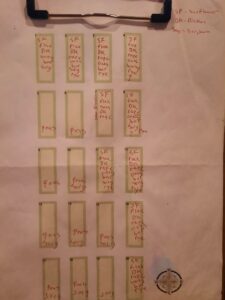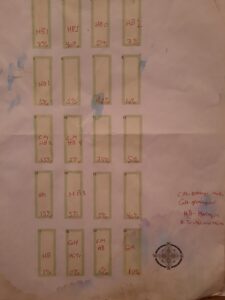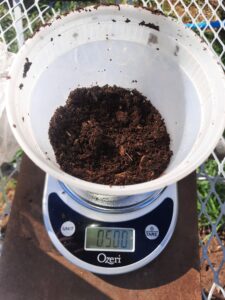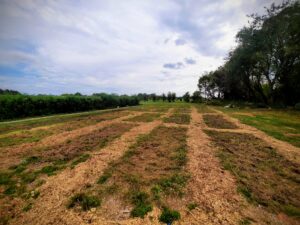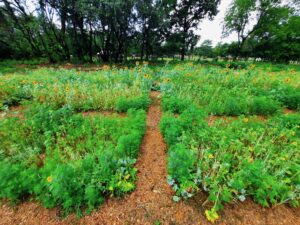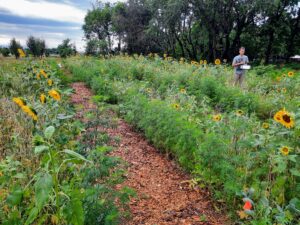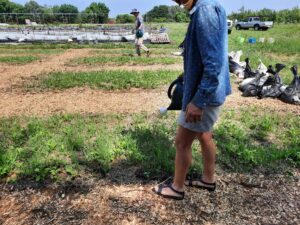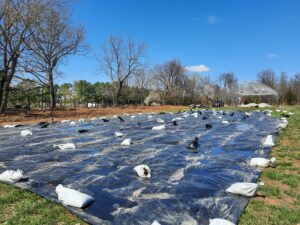Progress report for FS23-346
Project Information
This project will test the repeated use of biologically rich vermicast extracts and mixed cover cropping to identify changes in soil health and quantify changes in crop yields or quality post amendments. We will also identify disease and pest prevalence pre and post introduction of amendments to the soil.
The practice of planting crops in field blocks that are lacking a complete soil food web removes essential plant nutrients from the soil without replenishing them via plant root exudates working in tandem with proper soil biology. This leads to a diminishing yield each year as the soil continues to lose structure and available nutrients. We have observed that adding compost and rotating crops are efficacious practices for improving yields, but these practices rely on an endless reapplication of soil amendments (bulk broadcasted compost, manures, and agro-chemicals) which can be costly and labor intensive for farmers. Regenerative agriculture advocates report comparable yields with fewer yearly inputs by utilizing biological soil inoculants and diverse cover crops to cycle nutrients, increase soil carbon and sustain a balanced and complete soil food web. Vermicompost (worm castings) is as much as 60-70 times more efficient than conventional manure [1]. In a study testing vermicompost vs municipal compost, the vermicompost had significantly larger nutrient concentrations than the compost; when mixed with the soil, the vermicompost also had higher microbial population size and activity and produced increased ryegrass yields [2]. It would be beneficial to test the efficacy of preparing and applying extracts of microbial rich vermicast in a real market garden setting with more biodiversity than academic agriculture settings to better evaluate practical implications.
Combined with testing for vermicast use, studying how cover cropping can impact soil health with and without vermicompost or organic compost would be beneficial in understanding how these two practices work together to impact yields. In studies at the University of California, after two years of cover cropping, productivity was highest after cover crops with high nitrogen content and productivity significantly correlated with the structure of the soil fauna [3]. We will be using a smartmix developed by Green Cover based specifically on our soil needs as our diverse cover crop test.
We will have multiple test plots to combine usage of organic compost with vermicast extract, both in isolation and with neither amendment, all accompanied by diverse cover cropping, to identify the outcome of each of these practices in conjunction in a market garden setting.
[1] Joshi, R., Singh, J. & Vig, A.P. Vermicompost as an effective organic fertilizer and biocontrol agent: effect on growth, yield and quality of plants. Rev Environ Sci Biotechnol 14, 137–159 (2015). https://doi.org/10.1007/s11157-014-9347-1
[2] Tognetti C, Laos F, Mazzarino M & Hernández T (2013). Composting vs. Vermicomposting: A Comparison of End Product Quality. Compost Science & Utilization. 13. 6-13. 10.1080/1065657X.2005.10702212.
[3] DuPont T. S, Ferris H, Van Horn M (2009). Effects of Cover Crop Quality and Quantity on Nematode-based Soil Food Webs and Nutrient Cycling. Applied Soil Ecology. 41,2. 157-167. https://doi.org/10.1016/j.apsoil.2008.10.004
Hypothesis: The composted plots will initially outperform the plots that are only amended with vermicast extract but as the immediately available nutrients are used up in the compost the extracted plots will outperform in growth, brix levels as well as show less susceptibility to pests and disease.
Health of the cover crops will be measured by brix levels, soil tilth will be evaluated using a penetrometer, and prevalence of pests and disease will be ranked using the Daubenmire cover class method.
If our hypothesis is supported by the results of our experiment, this would address our problem of having to administer costly and labor intensive soil amendments to maintain soil health by validating the alternative approach of applying liquid extracts of biologically rich vermicast to our farmland.
Experimental Design Plot Layout: Our test plots will each be 5 feet by 15 feet to make it easy to observe and access the center of the patches from either side without stepping into the growing area. Each plot will have a total area of 75 square feet which should be large enough to account for any pockets of soil anomalies and still small enough to where we can have a minimum of 5 replications of each plot condition without taking away from too much of the total farmable area of our site.
A representative sample will be collected from each test plot prior to commencing with soil treatments to establish a baseline of the starting biology in the soil.
Most commercially available, packaged worm castings are devoid of life, having become inert through lack of moisture, oxygen, or sterilization practices. The vermicast we will use for this experiment will be fresh, living material, that has been inspected by Biodesic via a microscopy assessment to determine the castings we use for our extract has living bacteria, protozoa, nematodes, fungi, and microarthropods in adequate numbers. The appropriate strainer bag will be used to filter our extract to ensure no living worms or cocoons are introduced to the test plots during application.
Rainwater will be used to prepare the extracts to avoid the negative impacts of chlorine in the city water on the biology we seek to extract.
We will check the rainwater under the microscope prior to making extract to ensure there is no buildup of anaerobic organisms that would contaminate the extract.
After an extract is made we will check a sample of it under the microscope to ensure adequate levels and categories of soil food web organisms have been dislodged from the organic matter into our soil drench.
Once an extract has been prepared and approved by Biodesic we will apply the extract to the appropriate plots within 30 minutes of making it to prevent the organisms from depleting all of the oxygen in the water and dying off.
With each application of vermicast extract our control plots will receive the same amount of pure rainwater applied in the same manner as our soil drench extract is distributed but using a different vessel to avoid any biological contamination of the control. This will account for the additional moisture being a factor that will affect cover crop growth.
Data on the plots will be collected at regular intervals and we will apply statistical analysis on our results to understand any differences in outcomes for each test condition.
Cooperators
- (Researcher)
Research
In April, we initiated our soil health study by tarpping a 40'x100' area of the farm to eliminate existing vegetation, a low-impact method to prepare the ground. Following a three-week period, we uncovered the area and divided it into 20 8'x4' subplots using stakes and string. These subplots were designated for different treatments: compost only, vermicast only, compost and vermicast, and control (neither). A map was created to guide the application of treatments, with only Research Assistant 1 privy to it to maintain Research Assistant 2's objectivity during field analysis.
Collaborating with Biodesic, we conducted an initial assessment of insect and disease presence in the field block before treatment, which was minimal due to the absence of live vegetation. We then sowed a diverse cover crop blend from GreenCover.com, selected based on our objectives. Research Assistant 1 applied compost and vermicast to the designated plots, while ensuring all plots received equal watering to prevent biased results from the vermicast's additional water content.
Our partners at Biodesic assisted in analyzing the microbial content of the vermicompost from Ozark Compost and Swap, which was then used to create the vermicast. This process involved mixing 0.5 lb of vermicompost with 2 gallons of water, straining out large particles, and watering the plots with the resulting liquid blend. This process was repeated every three weeks until July.
During the summer, we focused on maintaining the study area by removing weeds, mulching pathways, and regular watering. In July, we assessed pest and disease presence on the cover crops and conducted a brix analysis on green matter from the cover crops to assess their nutritional quality.
After flail mowing the cover crops, we allowed the beds to rest until September when we reseeded cover crops and resumed the application of vermicast and water to the plots. Unfortunately, a freeze in October resulted in the loss of significant green matter, limiting further analysis during the winter months. However, we plan to reseed cover crops in mid-March and continue our study to assess the long-term effects of our treatments on soil health and crop productivity.
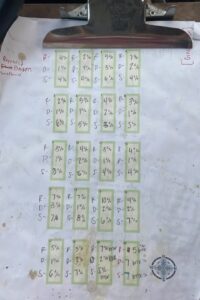
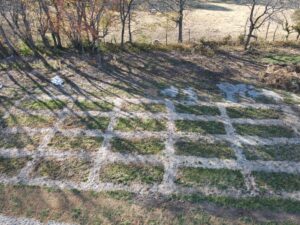
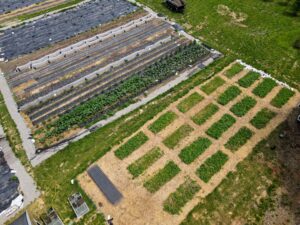
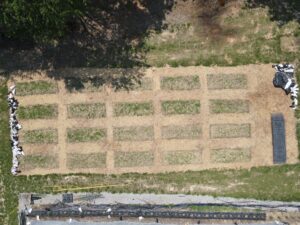
In our study, we assessed the effects of four different treatments on pest and disease prevalence, BRIX levels, cover crop diversity, and soil compaction using a soil penetrometer. However, we did not observe any clear differences between the treatments in the first year of the study.
For pest and disease prevalence, we documented the species of pests present in each plot and estimated the percentage of infestation. Similarly, we measured BRIX levels in three selected cover crop species in each plot. A statistician has volunteered to help us interpret the data collected, including measurements from the second year of the study.
We also documented the species of cover crop that germinated in each plot and observed a higher level of diversity in successful germination in some plots. Interestingly, there appears to be a pattern of higher cover crop diversity in the eastmost column and northmost row, although the reasons for this are currently unclear.
Additionally, we measured changes in soil compaction using a soil penetrometer but did not observe any major differences between the treatments.
Overall, our results suggest that there are no significant differences between the variables measured in the four different test conditions. This could be due to the time required to build a complete soil food web or the possibility of anomalies affecting our data due to our sample size.
Moving forward, the second year of observation may help us identify ways to improve the study and repeat it in the future. It may also provide us with clearer differences in yield, plant health, and pest prevalence that could guide future research in sustainable agriculture.
Educational & Outreach Activities
Participation summary:
At Samaritan Farm, we have established relationships with schools, businesses, churches, and clubs in Northwest Arkansas, hosting volunteer groups several times a month. These volunteer days serve as opportunities for educational outreach, where we demonstrate and discuss our regenerative agriculture practices. We plan to integrate our research into these sessions, providing visual demonstrations of the impact of different agricultural practices on soil health.
Formally, we are organizing educational workshops at the farm during each season, open to anyone interested in regenerative agriculture. These workshops will feature guest speakers from local soil experts such as Biodesic and Ozark Compost & Swap. Additionally, we are creating educational videos for our social media platforms, with the assistance of Samaritan's Creative Director, to share our practices and research with the wider community.
Update: We hosted at least 10 corporate and church groups for tours of the research plot, explaining our work and our plans to share our findings in 1.5 years. A group of 20 farming students from CAFF and 2 agricultural professionals also toured the plot, where we demonstrated our research methods. Additionally, we conducted a consultation with a farmer in Missouri on implementing similar practices at his farm.
We had four groups volunteer to help us build the plots, mulch the pathways, and weed the pathways. These activities not only supported our research but also provided hands-on learning opportunities for participants.
Looking ahead, we plan to expand our outreach efforts next fall when we have more data to share, including more workshops, tours, and educational materials to engage the community and promote sustainable agriculture practices.
Learning Outcomes
Farmers understanding their own ability to perform on site research, and how accessible it can be.
Farmers gaining understanding of the ability to use vermicast to enhance microbial soil life, which is much more affordable and easier to apply than they thought.
Farmers learning about how important it is to enhance soil first and foremost, and how that can feed the plants and prevent a lot of issues in the long run.
Project Outcomes
Our study aims to quantify the effects of vermicast application on pest/disease pressure and BRIX levels, providing valuable insights into the economic, environmental, and social benefits of this practice. Vermicast offers an economical solution for farmers, requiring minimal vermicompost and water to treat large areas of soil. This process is not labor-intensive and has the potential to save farmers time and resources compared to traditional compost or manure applications.
The environmental impact of vermicast extends to reducing the need for tillage and promoting beneficial insect populations, which can improve soil health and biodiversity on farms. While it is too early in our study to conclusively prove these effects, we anticipate that the use of vermicast will lead to these outcomes over time.
In addition to economic and environmental benefits, our project has the potential to contribute to the social sustainability of farming communities. By promoting practices that enhance soil health and crop productivity, we aim to improve the overall well-being of farmers and their communities. Through educational workshops and outreach efforts, we seek to empower farmers to adopt sustainable practices that benefit both their livelihoods and the environment.
While our study is ongoing and the full impact of vermicast may take up to two years to be realized, we believe that our findings will contribute valuable insights to the field of sustainable agriculture, supporting future efforts to enhance agricultural sustainability.
After working on this study, we also identified that it would be beneficial to study the methods of creating vermicompost effectively. At this time, many farmers are not making their own compost or vermicompost, and spending thousands of dollars annually. The creation of vermicompost on site could reduce farm expenses, but the best practices of vermicompost production on the farm is still something that needs further study. Many producers of vermicompost struggle to find a high fungal population in their vermicompost, so it would be interesting to test different production methods by analyzing their final product in terms of fungus and microbial life at the end.
- Cover crop diversity and improvement of soil health
- Cover crop diversity and reduction in need for irrigation
- Native cover crop mixes to provide ecosystem services while also improving soil health
- Perennial cover crops
